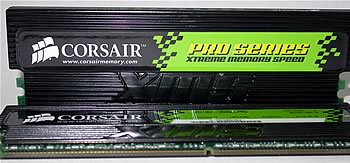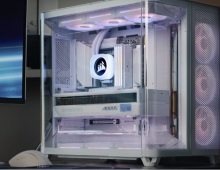Corsair 3500LL PRO
7. Overclocking
Corsair is known for using high quality memory chipsets with their modules, giving good overclocking potential and performance while at the same time maintaining high stability. Especially with the PRO series, we expect to see our system really fired up. But let's not keep you waiting any longer and on with the test...
The first thing we did is try to overclock a little bit, the memory to the rated 438MHz frequency. The Memtest we ran, reported no problems and no errors at all, as expected. Then, we increased by small increments, the operating frequency until the system became unstable, which was at 472MHz. Up until this point, we did not mess around with voltages, but only changed the FSB operating frequency.
We then increased the voltage to 2.9v and the memory became stable once again (at 472MHz). We could climb up to 554MHz (2 x 277.2MHz) with a stable system, but when we tried to go even higher, the system became erratic.

Timings at this high frequency remained considerably low at 3-4-4-10. In the overclocked state, the memory was no where near too hot to touch, and we might be able to go even higher, if we weren't worried about the motherboard getting toasted.

We re-ran some tests with the memory operating at 554MHz to see if there was any performance boost.







The SiSoft and PCMark05 tests did not report any noticeable boost in performance, and Sandra's speed factor was increased (slower performance). On the other hand, with all other tests, the memory was boosted way above normal. We had almost 18fps gain with Half Life 2, and this is something to scream about. The memory marks we got with Performance Test v.5.0 were 458.1, compared to 413.8 marks with the default frequencies.
In general, the overclocking potential of the Corsair 3500LL PRO was excellent, and with very good performance boost. After all, we could not except less from the Corsair PRO series!






















